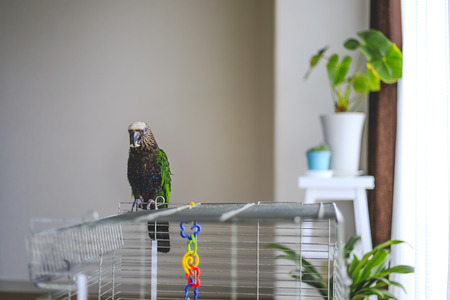Introduction to Pet Bird Training in the UK
In Britain, pet bird ownership has flourished into a vibrant subculture, celebrated for its distinctive blend of tradition and modernity. British households are home to a diverse array of avian companions, from cheerful budgerigars and inquisitive cockatiels to majestic African greys and colourful parrots. The popularity of pet birds in the UK is not merely a trend—it reflects a deep-seated appreciation for these intelligent creatures, as well as a commitment to their welfare and enrichment. Across the country, bird enthusiasts place strong emphasis on humane training techniques that prioritise positive reinforcement and mental stimulation over outdated coercive methods. This approach is rooted in the British respect for animal welfare, promoting an environment where birds can thrive emotionally and physically. As a result, bird training in the UK is often seen not just as a means to teach tricks or correct behaviour, but as an essential part of providing a happy, enriching life for feathered family members.
Understanding British Bird Species and Their Personalities
When embarking on the journey of pet bird training in Britain, it’s essential to first understand the most commonly kept species in British households and their unique personalities. Each species brings its own quirks, energy levels, and social needs, which will influence the most effective training approaches.
Popular Pet Bird Species in Britain
British bird enthusiasts typically favour smaller species that adapt well to indoor living and the UK’s climate. The table below highlights three of the most popular choices:
| Species | Notable Traits | Typical Personality | Training Considerations |
|---|---|---|---|
| Budgerigar (Budgie) | Small size, vibrant colours, vocal abilities | Highly social, playful, curious | Learns tricks quickly; thrives on regular interaction; benefits from positive reinforcement |
| Cockatiel | Crested head feathers, melodic whistles, affectionate nature | Sensitive, gentle, loyal to caregivers | Responds well to calm repetition; enjoys music-based training; may require patience with new experiences |
| Canary | Known for singing, bright plumage, independent spirit | Less interactive, easily startled, prefers minimal handling | Best suited to indirect training; focus on environmental enrichment and gentle routine establishment |
Individual Temperament Considerations
No two birds are identical—even within the same species. Factors such as age, gender, previous socialisation, and even regional breeding practices can impact a bird’s temperament. For instance, budgies bred by hobbyists in the Midlands might be more outgoing compared to those from quieter rural areas. Observing your bird’s body language—like feather position or chirping patterns—will help you tailor training sessions to suit their comfort level.
The Importance of Observation in Training Success
The foundation of successful bird training in Britain is recognising and respecting your pet’s individuality. Spend time simply watching your bird interact with its environment and household members. Are they bold and inquisitive or shy and reserved? This information is invaluable for choosing rewards (like millet sprays for budgies or soft whistling for cockatiels) and setting achievable training goals.

3. Positive Reinforcement and Clicker Training
Among bird enthusiasts in Britain, positive reinforcement stands out as the go-to method for shaping desirable behaviour in pet birds. Instead of focusing on punishment or negative feedback, UK bird keepers prefer to reward good behaviour with treats, praise, or gentle attention. This approach not only builds trust but also fosters a more harmonious relationship between owner and bird. In recent years, clicker training—a technique borrowed from dog training—has gained popularity across the UK aviculture community. Using a small handheld device that emits a distinct clicking sound, keepers can instantly mark a bird’s correct action before offering a tasty treat. The clear and consistent signal helps birds quickly associate specific behaviours with rewards, speeding up the learning process. Many British bird owners report remarkable success with this method, whether teaching parrots to step up onto a hand or encouraging finches to return to their cages. The growing trend towards positive reinforcement reflects the UK’s broader commitment to animal welfare and ethical pet-keeping practices.
4. Target Training and Recall Exercises
Among British bird keepers, target training and recall exercises have become central to creating a strong bond between owners and their feathered companions. These techniques not only foster trust but are also crucial for ensuring a pet bird’s safety, whether kept indoors or allowed limited outdoor access in secure gardens or aviaries.
Target Training: Building Focus and Engagement
Target training involves teaching a bird to touch or follow a designated object, such as a stick or coloured target. In Britain, many parrot and budgie owners use this method as it encourages mental stimulation and provides an easy way to direct birds without force. The process usually starts by rewarding the bird with a favourite treat each time it approaches or touches the target.
| Step | Action | Reward |
|---|---|---|
| 1 | Introduce the target (e.g., chopstick) | Treat when bird looks at it |
| 2 | Bird touches target with beak | Treat and verbal praise (“Good lad!”) |
| 3 | Move target further away to encourage movement | Treat for following and touching again |
Recall Exercises: Ensuring Safety Indoors and Out
Recall training teaches birds to return to their owner on cue, vital for British homes where open windows or doors can pose risks. Owners typically use a consistent whistle or call paired with treats. For those who enjoy supervised outdoor flights in aviaries, recall is especially important due to Britain’s unpredictable weather and local wildlife such as magpies or foxes.
Main Recall Techniques in British Homes:
- Verbal Cue: Use a distinctive call (“Come here!”) that is always paired with reward when the bird responds.
- Treat Association: Only offer special treats during recall sessions, making the response highly rewarding.
- Gradual Distance Increase: Start with short distances inside the lounge and slowly increase as reliability improves.
- Outdoor Practice: For those with secured gardens or aviaries, practice outside using harnesses or within enclosed spaces first.
Tips from British Bird Enthusiasts:
- Keep sessions short—birds tire quickly.
- Avoid training during busy tea times; choose quiet moments instead.
- Praise enthusiastically—even a “Well done!” in your best East End accent goes far!
By combining these practical methods, British pet owners find they can nurture well-behaved, happy birds while maintaining that special connection so cherished in UK aviculture circles.
5. Incorporating Enrichment in Training Routines
British pet bird enthusiasts are well-known for their commitment to animal welfare and making training sessions both stimulating and enjoyable. Integrating enrichment activities into daily training not only keeps birds mentally active but also strengthens the bond between owner and pet. Utilising a variety of toys, introducing foraging opportunities, and regularly altering the environment are popular approaches across the UK.
Suggestions for Using Toys
Toys play a pivotal role in British bird care routines. Puzzle feeders, chewable items made from safe woods, and swings are commonly found in aviaries and living rooms alike. Switching out toys regularly helps prevent boredom and encourages problem-solving skills during training. Many UK bird owners favour handmade or locally sourced toys, reflecting a preference for quality and sustainability.
Foraging Activities as Enrichment
Foraging is a natural behaviour that British keepers strive to encourage. Hiding treats inside cardboard tubes, wrapping seeds in paper parcels, or scattering favourite foods among clean branches mimics the search for food in the wild. Incorporating these tasks into training sessions adds an extra layer of challenge, making each interaction rewarding and fun for both bird and owner.
Environmental Change for Stimulation
The UK’s unpredictable weather often inspires keepers to create varied indoor environments. Simple changes like rearranging perches, rotating cage accessories, or introducing new sounds (such as soft British radio stations) help keep birds alert and adaptable. These environmental tweaks form part of routine training, teaching birds to cope with novelty—a skill much valued by British carers committed to lifelong welfare.
The British Approach: Welfare-Based Enjoyment
Ultimately, enrichment is at the heart of pet bird training in Britain. By blending toys, foraging activities, and environmental variety into daily routines, owners reflect a national passion for animal welfare and joyful companionship. This approach not only enhances birds’ lives but also ensures that training remains a positive, enriching experience that truly embodies the best of British pet care.
6. Challenges Unique to the British Environment
Training pet birds in Britain comes with its own set of challenges that are distinctly shaped by local conditions. The unpredictable British climate is perhaps the most prominent factor; frequent rain, dampness, and cool temperatures often mean that outdoor training sessions are limited or require extra preparation. Many bird owners find themselves relying heavily on indoor activities, which can constrain flight training and enrichment opportunities. As such, indoor housing norms play a significant role in how British bird keepers approach training. Homes tend to be smaller and windows are usually kept closed for insulation, so bird-safe rooms and secure play areas become essential for both exercise and teaching new behaviours.
Additionally, local wildlife interactions present unique obstacles. In suburban and rural areas, encounters with native species like magpies, sparrows, or even urban foxes can pose risks during any outdoor training or free-flight attempts. British trainers must be vigilant about supervising their birds and preventing accidental escapes, particularly since native predators or aggressive wild birds may be nearby. Furthermore, strict animal welfare regulations and respect for local wildlife encourage British pet owners to use positive reinforcement methods rather than aversive techniques, ensuring that their training practices align with national values of compassion and responsibility.
7. Community Support and Resources in Britain
One of the most charming aspects of being a pet bird owner in Britain is the robust community support available to both novice and experienced keepers. Across the UK, a network of local bird clubs offers invaluable advice and camaraderie, hosting meet-ups where members share their training successes, swap tips on positive reinforcement, and even arrange friendly training competitions for their feathered companions. Many of these clubs are steeped in tradition, yet they embrace modern welfare standards and training philosophies, ensuring that ethical practices remain at the forefront.
In addition to local clubs, British welfare organisations such as The Parrot Society UK and the RSPB provide guidance on responsible bird ownership and behaviour management. These organisations often run workshops or publish resources specifically tailored to common UK species like budgerigars, cockatiels, and canaries. Their focus extends beyond mere training; they promote enrichment strategies and highlight the importance of understanding avian body language—a skill essential for successful training outcomes.
The online landscape has also blossomed into a supportive space for British bird enthusiasts. Social media groups, forums such as The Bird Forum UK, and dedicated Facebook communities offer round-the-clock advice. Here, owners can post videos of their training sessions, seek feedback from seasoned trainers, or simply find reassurance when challenges arise. The sense of solidarity is palpable; sharing stories about persistent parrots or clever conures fosters a uniquely British spirit of encouragement and gentle humour.
For those embarking on their pet bird training journey, tapping into these community resources can make all the difference. Whether it’s attending a club meeting in your local village hall, joining an online Q&A session with avian experts, or reading up on welfare guidelines from established charities, Britain’s collective wisdom ensures that no owner need feel isolated. With such strong communal ties and shared knowledge, every bird—and owner—has the chance to thrive together.


